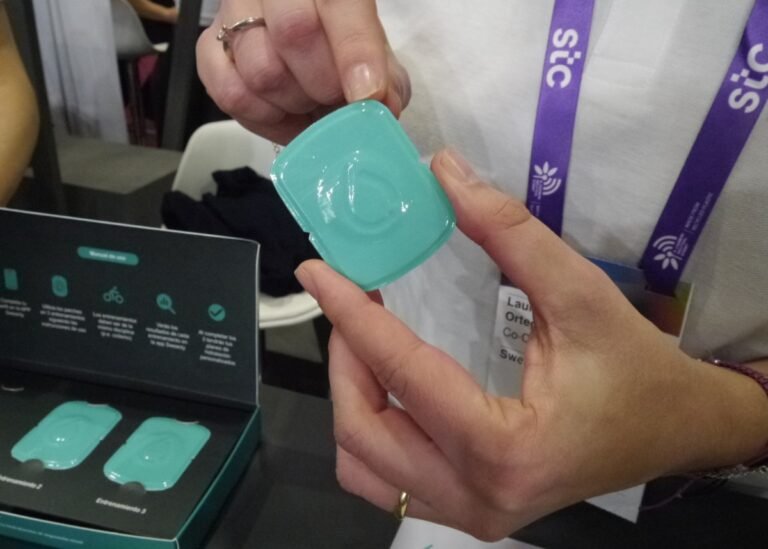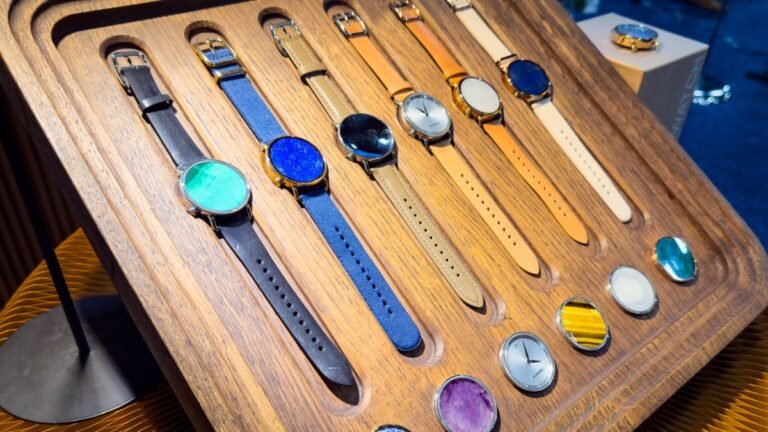
Here at 4YFN at the MWC tradeshow we spotted a new one: A stick-on patch for tracking athletes’ sweat to monitor salt loss and help them tailor their rehydration strategy.
Analysis of the patch wearers’ “sweatprofile” is sent to a companion app where they access their tailored hydration plan.
Proper hydration can boost sportspeople’s performance by helping to maintain energy levels and endurance, as well as reducing the risk of cramps, per Ortrega Tañá.
Sweanty’s wearables are not yet available for athletes to buy but the startup expects to launch them in Spain by the end of April.
(Swimmers or other sports where the user is immersed in water are an exception; they will have to stick with manual methods for tracking salt loss such as weighing themselves before and after their session.)

Muscle mass tends to decline as you get older, impacting your walking and increasing the risk of falls.
“Using the wearable robot EX1, older adults can effectively perform simple exercises such as walking and fitness, thereby improving their quality of life,” says research lead, Professor Wan-hee Lee.
“Our findings provide a solid foundation for developing various types of improved and advanced wearable robots,” Lee.
“This will further expand the global wearable robot market, promoting further research and commercialization.”It’s not certain when or if the Samsung EX1 might actually hit the market.
Even so, anticipate assistive wearable robotics becoming a lot more prevalent over the next decade.

The product is a relief within the constant buzz of notifications and fitness goals and the relentless race against time.
Bring on the AIThe company uses its AI back end to learn the wearer’s biorhythms and can send gentle personalized vibrations to remind you to calm the hell down, already.
“I would like to see if her heart rate heart is going into certain zones that might be worrying.
He also points out that the company is seeing increased interest in B2B sales, especially in stress management and scientific research.
I love a good oddball curveball company, and it was interesting to see the company continue to grow and evolve.

Serenity, the result of a fruitful partnership with Alarm.com, is an innovative fall-detection system that does away with traditional wearables.
What sets Serenity apart is its ability to construct a 13-point skeleton model of individuals in near-real-time, using radar data processed by AI on the device.
This model helps distinguish between intentional lying down and falls, including slow falls that traditional accelerometers fail to detect.
from a distance, without any wearable device – a feature that has far-reaching implications for home healthcare.
“Serenity isn’t just a product; it’s a promise of independence, safety, and peace of mind for our aging population.”

“Verve is pioneering a new class of connected wearable technology for the industrial sector by integrating robotics into functional apparel,” Galiana said.
But Galiana perceived applications well beyond combat; Galiana launched Verve in 2020 to commercialize his and his team’s tech for industrial as well as retail and manufacturing settings.
Verve’s mission is to power the human workplace through people-centric robotics.”Verve’s powered exosuit is customizable to workers and tasks, intended to be worn like a regular backpack.
“The challenge [we face] is to convey that the goal is to create a safer and more efficient future for industrial workers,” Galiana said.
“As we heighten awareness regarding the advantages of soft exosuit, we anticipate a rapid transition towards a future where wearable robotic technology seamlessly merges with our everyday work attire.”Aspirational?








